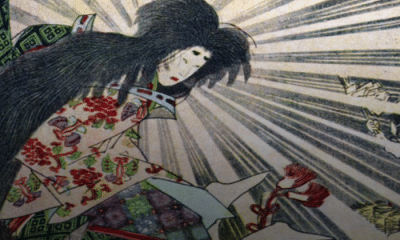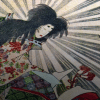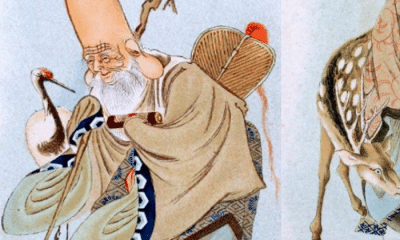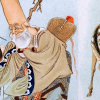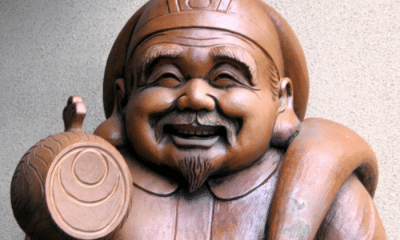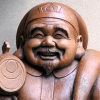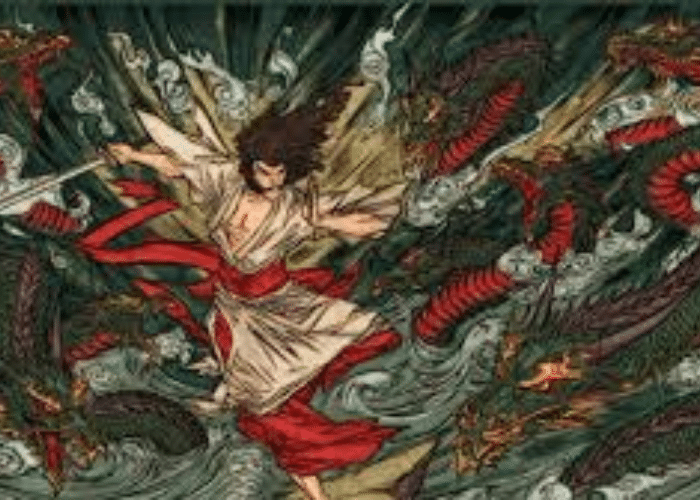
Japanese
Susanoo: The Japanese God of Storms
Susanoo: The Japanese God of Storms
What happened when the Japanese storm god lost his temper? Keep reading to find out all about Susanoo and why he was thrown out of Heaven!
Susanoo was the god of the sea in Japanese mythology. Because of the islands’ weather patterns, this meant that he was also strongly associated with storms and rain.
He was the brother of Amaterasu, the goddess of the sun and the ruler of Heaven. The two did not get along well, however, which ultimately led to Susanoo’s most famous adventure.
Exiled to earth for his violent temper, Susanoo redeemed himself by saving a young woman from a terrible dragon. In doing so, he also won a prize that is revered as a symbol of power in Japan to this day.
From his birth as one of the greatest kami to his eventual place as the guardian of the Underworld, Susanoo’s story made him important in many aspects of Japanese life.
Susanoo’s Many Names
Susanoo goes by a variety of names in his native Japanese.
The exact meaning of his name is not known. It is often said to have come from the verb susabu (to commit violence or act impetuously) or susumu (to advance).
Some linguists even believe that the name is not of Japanese origin at all.
They claim that it comes from a Middle Korean word for “shaman” or “master.” Some of Susanoo’s myths seem to include references to Korea and the region of Western Japan closest to the peninsula, making it a possibility that Susanoo did actually develop there.
Various honorifics are attached to his name in different texts. These include haya (swift), take (brave), and kamu (divine).
Like other kami, or god-like spirits, Susanoo’s name is often written with –no-Mikoto (the Great God).
Not only can Susanoo’s name be written in a variety of ways in his own language, but its translation into English has also led to several spellings. English approximations of the Japanese name have been spelled as Susan’o, Susano-o, or even Sosa no wo.
The Birth of the Three Great Gods
According to legend, Susano was one of the “Three Precious Children” born to the creator god Izanagi.
Izanagi’s wife had died and he made an attempt to journey into Yomi, the Underworld, to bring her back. She turned against him when he saw her decaying form, however, and Izanagi barely escaped.
When he returned from Yomi, Izanagi purified himself by bathing in a river. When he washed his face, his three children were born – Amaterasu from his left eye, Tsukuyomi from his right eye, and Susanoo from his nose.
Izanagi proclaimed that these three were the most blessed and powerful kami and had the right to rule in Heaven. Amaterasu became the goddess of the sun, Tsukuyomi was the moon god, and Susanoo was given control over the sea and storms.
Even at birth, Susanoo was the most brash and violent of the siblings. Izanagi hoped to temper his unpredictable nature by making him the guardian of Heaven.
Despite this duty, it soon became obvious that Susanoo was too destructive and emotional to fit in the highly-structured environment of Heaven. According to some myths, he cried so horribly because he missed having a mother that his wails shook the earth and his tears caused widespread floods.
Because of this, Izanagi banished his youngest son from Heaven.
Susanoo’s Crime
Susanoo was ordered to leave Heaven because he did not fit in there, but had committed no terrible crime. He was therefore given permission to return in order to say goodbye to his sister, Amaterasu.
When he traveled to Heaven, however, the earth shook. Because he and Amaterasu had argued in the past, she doubted his reasons for visiting her again.
Sosa no wo no Mikoto said:—’All the Gods have banished me, and I am now about to depart for ever. Why should I not see my elder sister face to face; and why take it on me of my own accord to depart without more ado?’ So he again ascended to Heaven, disturbing Heaven and disturbing Earth. Now Ame no Uzume, seeing this, reported it to the Sun-Goddess. The Sun-Goddess said:—’My younger brother has no good purpose in coming up. It is surely because he wishes to rob me of my kingdom. Though I am a woman, why should I shrink?’ So she arrayed herself in martial garb.
-Nihongi (trans Aston)
Susanoo proposed a trial to prove his sincerity when he saw that his sister was prepared to fight him. Each of them would chew an item belonging to the other and spit out new kami.
Amaterasu broke Susanoo’s sword into three pieces and chewed them up. She spit out three female goddesses.
Susanoo took the magatama beads that his sister wore in her hair and spit out five male deities.
Amaterasu, however, had attempted to trick her brother. She declared herself the victor because the greater number of kami had been created from her item instead of by her action.
Susanoo was furious. Although his intentions had been peaceful, he now became enraged and violent.
He destroyed his sister’s rice fields and defecated in her palace. He then flayed one of her prized piebald horses and threw it at her loom.
When he threw the horse, it struck and killed one of Amaterasu’s maids. The sun goddess was so afraid of her brother’s rampage that she hid in a cave, plunging the world into total darkness.
The other gods eventually persuaded Amaterasu to come out and met to determine how to punish Susanoo.
The God in Exile
Eight hundred kami met to discuss how Susanoo would be punished for his crimes against Amaterasu and her property.
His punishments included:
- He was ordered to pay a costly restitution, amounting to nearly the entire value of his wealth.
- His beard was cut off.
- His fingernails and toenails were removed or, in some translations, cut.
- He was banished permanently from Heaven.
One account claimed that when Susanoo was banished from Heaven he wandered aimlessly in search of food. This story claims that he, not Tsukuyomi, killed the goddess of food when he saw her disgorging plants and animals.
Another legend claimed that Susanoo descended to a place called Soshimori in Korea. Disliking the land there, he crafted a boat and sailed to Izumo in Japan.
As he walked along the banks of the River Hi, he heard someone crying. It was an elderly man named Azinazuchi who, despite his own stress, invited the stranger into his home.
Azinazuchi introduced Susanoo to his wife and their daughter, Kushinadahime. He then revealed the source of his grief.
An eight-headed serpent named Yamata-no-Orochi lived nearby. It had already devoured seven of the couple’s daughters and was now on its way to take Kushinadahime, their last surviving child.
Susanoo sympathized with Azinazuchi and his wife and offered to help them keep their daughter safe. He turned her into a comb, which he put in his hair to hide her from the serpent.
He instructed the couple to make a thick sake that was brewed eight times. He then had them build a fence with eight gates.
At each gate, they built a platform and placed a large basin of the thick sake on it. When the eight-headed dragon appeared, it was lured by the drinks and plunged each head deep into one of the basins.
Yamata-no-Orochi soon became so drunk that it was completely incapacitated. It passed out and Susanoo was easily able to cut it into pieces.
Following the serpent’s death, Susanoo married Kushinadahime. Her father became the headman of Susanoo’s new palace on earth, Suga, and the family led a happy life.
Susanoo took other wives, having many children who became powerful kami, but Kushinadahime was always his primary wife.
Despite their happiness, however, Susanoo still longed to return to Heaven. The dragon provided him with a way to make amends with his sister.
Susanoo’s Gift of Penance
When Susanoo killed Yamato-no-Orochi and cut its body apart, he discovered something surprising in its tail.
As he plunged his sword into the tail, it broke into pieces. Susanoo was surprised because it was a well-made sword, but continued to use the broken blade to hack the tail apart.
Once it was opened up, he saw was had broken his sword. It was another blade, this one of exceptional strength and beauty.
This new sword was called Kusanagi-no-Tsurugi (the Grass-Cutting Sword), although it was also sometimes referred to as Ame-no-Murakumo-no-Tsurugi (the Sword of the Gathering Clouds of Heaven).
Susanoo decided to give this miraculous sword to his sister as a way of making amends with her. Amaterasu accepted the gift and make peace with her brother.
In time, Ame-no-Oshihomimi, one of the gods Susanoo had made from Amaterasu’s beads, had a son. Ninigi was Amaterasu’s grandson because she had claimed the kami Susanoo made as her own.
When he was sent to rule the earth, his grandmother gave Ninigi three gifts. Kusanagi-no-Tsurugi was one of these.
According to tradition, Amaterasu’s gifts were passed down through her descendants who ruled Japan. Ninigi’s great-grandson, Jimmu became Japan’s first emperor and the sword Susanoo gave his sister is still passed on as part of the Imperial Regalia, Japan’s greatest treasures.
The Ruler of the Underworld
Although he had been forgiven by Amaterasu, Susanoo was still exiled from Heaven. Even though his crimes were no longer held against him, Izanagi knew that Susanoo would always be too stormy to live peacefully there.
Instead, Izanagi commanded his son to complete his penance by becoming the lord of Ne-no-Kuni instead of Heaven. He was to guard the gateway between this realm and the mortal world.
Meaning “The World of Roots,” Ne-no-Kuni was a dark underground realm from which plants were formed to push through the earth’s soil. Although it may have originally been separate from Yomi, the land of the dead, the two were similar enough that many sources conflate them.
Susanoo accepted this position and became a god of the Underworld. Strong storms were associated with Yomi or Ne-no-Kuni because the storm god lived there.
As a storm god, Susanoo’s association with the Underworld was probably once linked to the role rain played in causing new plant life to emerge from the soil. In one story, for example, he created three trees from his hair and gave them to his children to plant throughout Japan.
In another tale, six generations after Susanoo took his place in Ne-no-Kuni one of his descendants fled there to escape his violent brothers. After a series of tests, he was allowed to marry Susanoo’s daughter and was renamed Okuninushi, the undisputed ruler of the terrestrial world.
As he became more associated with Yomi, however, stories of Susanoo’s violent temper grew.
In later periods, Susanoo became more closely associated with ideas of calamity, violence, and death. Many people came to see him as a source of disease and misfortune.
Susanoo is a character that shows great malevolence and great heroism. While he attacked the sun goddess and became the ruler of the netherworld, he also saved an innocent girl from a monster and provided Japan with one of its most sacred relics.
Historians believe that the role of Susanoo changed over time, largely because that of the Imperial Family did as well.
The Emperors of Japan legitimized their rule through descent from Amaterasu. Some historians believe that as she became a more important symbol of political power, her brothers were rewritten to provide foils for her.
To prove her own rule, Amaterasu would have to defeat enemies as powerful as herself. The banishment and vilification of both Susanoo and Tsukukami provided a way for her, and her human descendants, to have an unchallenged rule.
With Amaterasu as the official patroness of Imperial power, Susanoo also became a symbol of those who opposed this rule. Some historians believe that he originated in a minority culture, perhaps a Korean minority in Japan, that was exiled for refusing to honor the rule of early emperors.
Stormy Susanoo
Susanoo was the storm god in Japanese mythology. He was linked to the sea and rain, but eventually became more closely associated with violent and threatening storms.
He was the brother of Amaterasu, one of the three children born after Izanagi returned from Ne-no-Kuni. The three were given control over Heaven, with Amaterasu as its ruler.
Susanoo was too temperamental to remain in Heaven, however, and was banished to earth. He tried to say goodbye to his sister, but she doubted his motives and prepared for a fight.
The two held a contest to prove his sincerity, but Amaterasu tricked him into an unearned loss. Furious, he destroyed much of her property.
Exiled permanently, Susanoo met an elderly couple whose last living daughter was going to be eaten by a dragon. He temped the beast with strong sake and killed it when it passed out, saving and marrying the girl.
In the dragon’s tail he found a sword which he gave to his sister to make amends. This sword became part of the Imperial Regalia of Japan.
Susanoo was eventually sent to Ne-no-Kuni to guard its gateway. While originally showing his link to plant growth as a rain god, this eventually caused Susanoo to be portrayed as a god of death and calamity in many texts.
As Imperial power grew, Susanoo was placed in the role of an opponent that was defeated by rightful leadership. He was never a complete villain, however, as the rain he sent was still vital for Japanese farmers.


